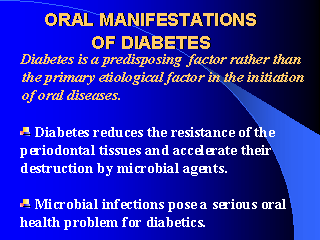|
|
|
|
front |1 |2 |3 |4 |5 |6 |7 |8 |9 |10 |11 |12 |13 |14 |15 |16 |17 |18 |19 |20 |21 |22 |23 |24 |25 |26 |27 |28 |29 |30 |31 |32 |33 |34 |review |
 |
Oral Manifestations of Type 2 Diabetes Mellitus:
While a wide spectrum of oral manifestations of Type 2 DM has been reported in the dental literature, the greater number of studies focuses on linking diabetes to severe periodontal destruction. These investigations have reported a significant increase in the prevalence and severity of periodontal disease in the diabetic individual as compared to the non-diabetic individual, while others show no differences. In addition to advanced periodontal disease, other oral conditions associated with diabetes mellitus that are described in the literature include: dental caries, xerostomia, abnormal taste, prolonged or recurrent fungal and bacterial infections, and burning mouth syndrome. The precise role of diabetes mellitus and the mechanisms involved in the etiology of periodontal disease are not completely understood. The influence of diabetes mellitus on the onset and development of periodontal disease has been an on-going study. Based on experimental and clinical investigations, it is generally accepted that diabetes is a predisposing factor that reduces the resistance of the periodontal tissues and accelerate their destruction by microbial agents. microbial infections pose a serious problem for diabetics, who often exhibit depressed host defense and repair mechanisms that may be either intrinsic or secondary to loss of diabetic control. Two important concepts have emerged as a result of periodontal research:
Among these periodontal pathogens are: Actinobacillus actinomycetemcomitans, Bacteroides gingivalis, Bacteroides intermedius, and Wolinella recta. Studies of the subgingival microflora in patients with diabetes mellitus suggest the importance of these same periodontal pathogens. |